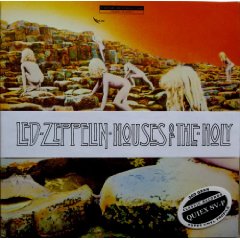

Released 28 March 1973
Recorded January–August 1972,
Stargroves and Headley Grange with the Rolling Stones Mobile Studio, and Island Studios, London.
Mixed at Olympic Studios, London and Electric Lady Studios, New York City
Singles from Houses of the Holy
1. "Over the Hills and Far Away/Dancing Days"
Released: 24 May 1973
2. "D'yer Mak'er/The Crunge"
Released: 17 September 1973
Houses of the Holy is the fifth album by English rock band Led Zeppelin, released by Atlantic Records on 28 March 1973. The album title is a dedication by the band to their fans who appeared at venues they dubbed "Houses of the Holy." It was the first Led Zeppelin album to not be, at least unofficially, titled after the band, and was also the first of the band's albums to be composed of completely original material. It represents a musical turning point for Led Zeppelin, as they began to use more layering and production techniques in recording their songs.
Recording sessions
Much of this album was recorded in Spring 1972 at Stargroves, the country estate in Berkshire which was owned by Mick Jagger, through the use of the Rolling Stones Mobile Studio. Some songs from the album had initially been tried out earlier than this, such as "No Quarter", which was first attempted during a session at Headley Grange.
Several of the songs were also demoed at the personal studios of guitarist Jimmy Page and bass player/keyboardist John Paul Jones. These two musicians had recently installed the studios in their respective homes, which enabled them to complete the arrangements which had been laid down earlier. In particular, Page was able to present complete arrangements of "The Rain Song" and "Over the Hills and Far Away", while Jones had developed "No Quarter".
Another bout of recording took place at Olympic Studios in May 1972, and during the band's 1972 North American tour additional recording sessions were conducted at Electric Lady Studios in New York.
Some songs which were recorded from these various sessions did not eventually make it onto Houses of the Holy, namely "Black Country Woman", "Walter's Walk", "The Rover" and also the title-track, "Houses of the Holy". All of these songs were retained and later released on subsequent Led Zeppelin albums.
Composition
This album was a stylistic turning point in the lifespan of Led Zeppelin. Guitar riffs became more layered within Jimmy Page's production techniques and departed from the blues influences of earlier records.
In the album's opening opus, "The Song Remains the Same", and its intricate companion suite, "The Rain Song", Robert Plant's lyrics matured toward a less overt form of the mysticism and fantasy of previous efforts. Houses of the Holy also featured styles not heard on the first four Led Zeppelin albums. For example, "D'yer Mak'er" is a reggae-based tune (the name of the song being derived from the phonetic spelling of the British pronunciation of "Jamaica"); "No Quarter" features atmospheric keyboard sounds and an acoustic piano solo from John Paul Jones; "The Crunge" is a funk tribute to James Brown; and "The Rain Song" is embellished by Jones on his newly-acquired mellotron. The album's closing song "The Ocean", which featues an a cappella section and a doo-wop influenced coda, is dedicated to "the ocean" of fans who were massing to Led Zeppelin concerts at this point of the band's career.
According to Led Zeppelin expert Dave Lewis:
In retrospect, 'Houses of the Holy' holds its ground with the middle period releases quite admirably. The barnstorming effect of the early era was now levelling off and though devoid of the electricity of 'Led Zeppelin I' and 'II' or the sheer diversity of the third album, and lacking the classic status of the fourth, 'Houses' took stock of their situation. In doing so, it laid several foundations on which they would expand their future collective musical aspirations.
Album sleeve design
The cover art for Houses of the Holy was inspired by the ending of Arthur C. Clarke's novel Childhood's End.(The ending involves several hundred million naked children, only slightly and physically resembling the human race in basic forms.) It is a collage of several photographs which were taken at the Giant's Causeway, Northern Ireland, by Aubrey Powell of Hipgnosis. This location was chosen ahead of an alternative one in Peru which was being considered.
The two children who modelled for the cover were siblings Stefan and Samanatha Gates. The photoshoot was a frustrating affair over the course of ten days. Shooting was done first thing in the morning and at sunset in order to capture the light at dawn and dusk, but the desired effect was never achieved due to constant rain and clouds. The photos of the two children were taken in black and white and were multi-printed to create the effect of 11 individuals that can be seen on the album cover. The results of the shoot were less than satisfactory, but some accidental tinting effects in post-production created an unexpectedly striking album cover. The inner sleeve photograph was taken at Dunluce Castle near to the Causeway.
Like Led Zeppelin's fourth album, neither the band's name nor the album title was printed on the sleeve. However, manager Peter Grant did allow Atlantic Records to add a wrap-around paper title band to US and UK copies of the sleeve that had to be broken or slid off to access the record. This hid the children's buttocks from general display, but still the album was either banned or unavailable in some parts of the Southern United States for several years.
* Barry Diament – mastering (original Compact Disc release)
* Keith Harwood – mixing
* Hipgnosis – sleeve art direction
* Andy Johns – engineering, mixing (on "No Quarter")
* Eddie Kramer – engineering, mixing
* Bob Ludwig – mastering engineering
* Aubrey Powell – cover photography
* George Marino – mastering (remastered Compact Disc)